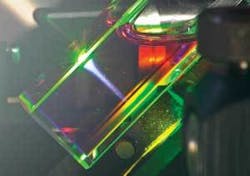Upconversion fluorescence achieved through incoherent excitation with sunlight
Researchers at the Max Planck Institute for Polymer Research (MPI-P; Mainz, Germany) and Sony Deutschland, Materials Science Laboratory (Stuttgart, Germany) have demonstrated frequency upconversion of sunlight using a process that depends neither on the use of coherent light sources to provide simultaneous absorption of two or more photons, nor on superhigh light intensities on the order of megawatts or gigawatts per square centimeter.
The process relies instead on resonant single-photon absorption in two-component (bimolecular) systems in which available triplet states of the sensitizer molecules or of the host molecules enable storage of photonic energy long enough to combine two excited states and emit light at higher frequencies. As a result, the efficiency of this upconversion-fluorescence process depends on material properties rather than coherence of excitation photons, and the photophysical characteristics of the process are dramatically different from two-photon absorption, second-harmonic generation, and other photon-upconversion methods. The materials used consisted of either thin films of metallated porphyrin macrocycles as sensitizers blended in a matrix of blue-emitting molecules with high fluorescence quantum yield-such as polyfluorenes and polypentaphenylenes-or solutions with sensitizer porphyrin sensitizers and diphenyl anthracene. The incident sunlight was filtered to pass only green frequencies and then upconverted to blue. External efficiency in excess of 1% was achieved for the systems in solutions. The researchers are working on increasing the process efficiency and broadening the energy range of the upconverted photons. Contact Stanislav Baluschev at [email protected] or Tzenka Miteva at [email protected].

